- MaikP
- Curiosità
- 2901 views
Snowboard Splitboard, here is my personal experience.
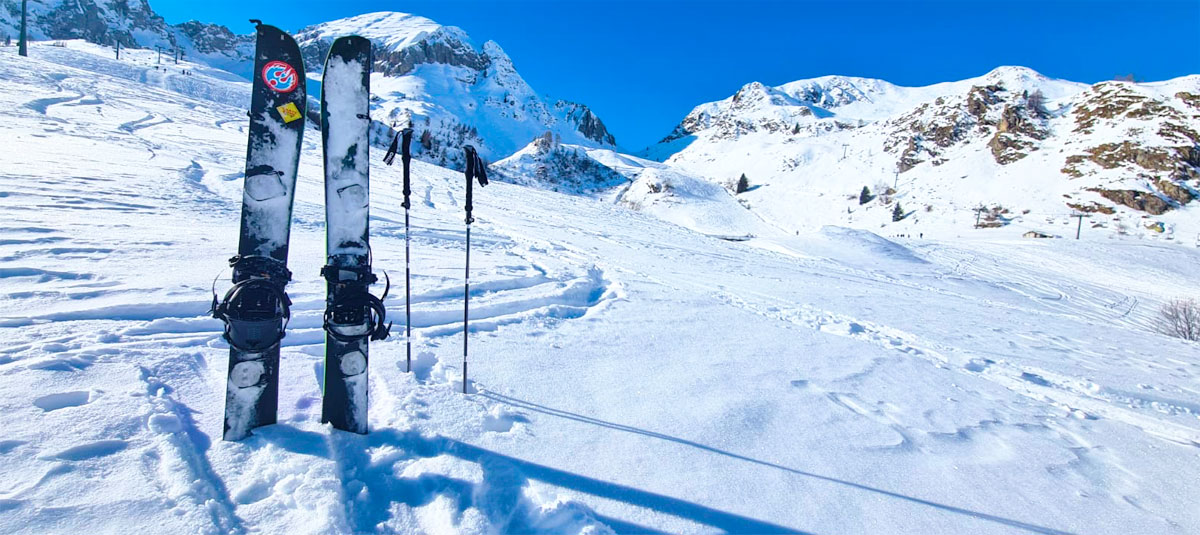
PREFACE
2020, lockdown, everyone's nightmare sli Snowborders.... we all know the disaster that happened, people who loved the mountains found themselves unable to go skiing, everyone went running, took the dog out and what do I do? You think you got a split? And I didn't, I got a snowskate and I went to the mountains in a snowskate, that's to tell you that in the end I didn't start splitting in 2020 like so many others, I spent my 2020 in the mountains in a snowskate.
But now let's get to the point, January 2022, Phill Magazine organises winter tests for us retailers with the 2023 Snowboard equipment trials, naturally I don't miss the chance and I go and try out some of the new products, one of the most important new products I tried out was the Union rover, a sort of skis with seal skins incorporated, I try them out and I see that they really are a bomb for climbing with little effort, or rather it's slightly less effort than climbing on foot. I came home feeling good and put on my Nitro Splitboard Doppleganger with spark bindings, the great thing about Nitro is that they give you the complete package with the skins cut to size, split bindings and folding poles, in short everything you need to split.
2023 MY FIRST REAL SPLITBOARD EXPERIENCE
Season 2022, between little snow and little time, I can't manage to try my new Splitboard. December 2022 arrives, I see on Instagram my friend Max Cattaneo in a video where he's in the mountains splitboarding, ( he's already been splitboarding for years ), I contact him and tell him: "Max you have to take me splitboarding with you." We managed to organise and in January 2023, we left for San Simone (BG), a place I know very well because I've been there many times in the past to snowboard, but now the lifts are closed for bureaucratic reasons.
Now I'll tell you about my first impressions. Of course you start off with the board split and you stick the seal skins underneath (they are called that but in truth they are made of synthetic material). Ready with skins and poles for the ascent, after the first few metres I realised that in order to advance well, you don't have to lift your foot, but it's better if you take advantage of the ski skidding. Now I don't want to tell you that I didn't struggle, but in my opinion it's less hard than snowshoeing or walking and above all you go slightly faster in the flatter parts because you take advantage of the ski skidding.
The first ascent for me, however, was quite tiring but doable, I take my time with the splitboard, I don't have to prove anything to anyone, and also being the first time I tried it, I didn't want to overdo it, I did 1 km and 500 metres of ascent, with more or less 200 metres of elevation gain. If you know San Simone, we started from the car park and arrived above, where there is the Chamois jump.
When I arrived at the prefixed point I took the split off my feet, and I positioned myself to film Max and Hera, his super freerider dog, with my drone, Max is very well trained, practically when I stopped he wasn't even tired, once I lost sight of him, I stayed there for a while to film myself with the drone and I prepared the split in descent mode.
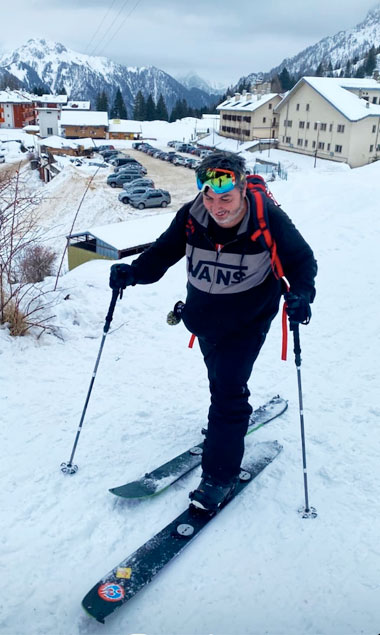
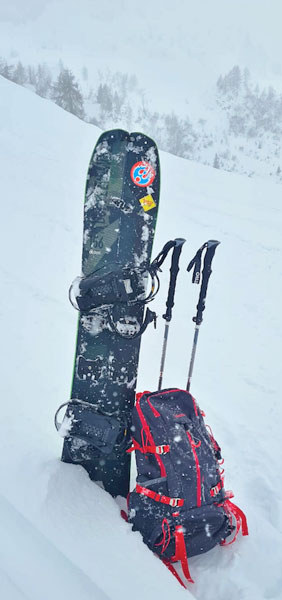
ARRIVED AT THE TOP
While I was waiting for Max to get back to me, I prepared just the board for the downhill mode. I peeled off the seal skins (the skins are adhesive and stick to the base like a sticker) once peeled off, I put them back in the rucksack, sticking them back in their smooth plastic, so that they don't stick to each other inside the rucksack, another thing to do is to fold up the poles used for the ascent, these too must be put away in the rucksack. The last step to complete is to take the board split into 2, remove the bindings and reassemble it in Snowboard mode, hence the name "Splitboard", precisely because it is a board that splits into 2 and creates 2 skis, for the ascent. Once the board is reassembled, you take the 2 bindings and in a very simple way and without the aid of screwdrivers, you reassemble them in snowboard downhill mode, I chose a 54 cm wide footstep, (I'm 1.71 cm tall), with +24 degrees in the front binding, and +15 in the back binding, my downhill stance is regular.
THE DESCENT.
Here comes the best part, and the surprise. Yes, because the split board in snowboard mode looks like a normal snowboard to the eye, but in truth it's not really like that, let's start with the bindings. I chose Spark bindings, which in my opinion, and in the opinion of many other people, are the best bindings in the splitboard world, in snowboard mode they are very comfortable, honestly I didn't find much difference from my traditional snowboard bindings, but the thing that upset me a bit was the board, Yes, as long as there's fresh snow it behaves very well, if you think about it, it's a board that's mainly used in fresh snow situations, but it has to be said that at some point, sooner or later you'll find yourself, as happened to me, on a slope or in icy terrain, and that's where the difference from a normal board comes in.
Mine is a Nitro Doppleganger, the shape if we compare it to a non splitboard deck, is a directional shape, very accentuated with a very small tail, this in fact works great in powder, but on the piste at the beginning it was a bit strange, right from the first few metres, when I went to brake with the heel edge, the board braked very little, during the turns it wasn't reactive, and in the edge changes and it tended to counter-slope a lot, so much so that it even made me fall into a counter-slope, I hadn't fallen into a counter-slope for 15 years, this happens because the board is split in the central part, the central edges touch the snow when the board goes into torsion, to get around this problem I noticed that you have to push and make force with the back foot. Once you understand how to do it, the problem is solved. I think that if I had never used another type of snowboard, I probably wouldn't have even noticed the problem, however if you're used to the normal board, after a few hundred metres, you realise how to put the weight on, and you go like a train.
MY POINT OF VIEW.
I think that splitboarding for a snowboarder is a new way of approaching the mountains, ski mountaineering is a whole different adventure, you don't have to be in a hurry, you have to have the right equipment, you definitely have to have a good technique for going downhill in fresh snow, another thing that should not be missing is the passion for the mountains, going up to places with silence, I think splitboarding is not a sport for everyone, not only because of the effort involved in the ascent, but also because of many other factors, one of which is the price of the equipment, which is certainly not cheap, and it's not the traditional snowboarding that we are used to. Splitboarding is a totally different sport, you go up slowly, without frenzy, you have to enjoy the ascent as well, when you get to the top maybe you stop to drink a nice hot tea carrying a thermos from your rucksack, you rest while enjoying yourself and looking at the splendid panorama around you, once you've caught your breath you get ready, get dressed and go down enjoying the fresh snow, in the only descent of the day.
CONCLUSION, WHAT DO I THINK ABOUT SPLITBOARDING?
I'll be honest, if someone had told me 20 years ago, look, one day you're going to go to the mountains with a pair of skis that turn into a board, you're going to do two hours of uphill to do one descent, I probably would have laughed in the face of the guy or the chick talking to me.
I was born as a Snowboarder coming from Skateboarding, I always preferred the park the jumps the rails but especially the Halfpipe. I have participated in regional competitions and Italian Halfpipe and Big air championships, I have always seen my way of Snowboarding as a winter extension of my Skateboard. Over the years, of course, everything changes, jumps and rails are done less and less, and my level of freestyle snowboarding has also changed. To be honest, I don't even really want to do rail jumps anymore, maybe my age, family, work and all my commitments have led me to make different choices.
I've been snowboarding since 1993, I've never stopped snowboarding and I've always loved it. Snowboarding is part of my life, just like skateboarding is part of my life, Thinking about which way is best to go up, what to take with you, when you get to the top figuring out how to approach the descent, finding and trying new mountains where there are no lifts, it's really a feeling I haven't had in years, I feel like I just started snowboarding. Right now I can tell you that if you put me in front of a choice, "would you rather go up the mountain on the lifts, or go splitboarding?" my answer is splitboarding 10 times to 1, I know it's a strange thing, preferring to work hard rather than just enjoy the descents, but I swear that I feel so good that going uphill doesn't become a problem, in fact it may seem strange, but the best thing is the climb, maybe because you do it with your own strength, and when you get up and look down you really feel like a super hero, I think that's what it is.
You want my advice? Try the Splitboard, buy it, rent it, borrow it but try it, once you've tried it then make your own evaluation, you'll see that you won't regret it.
Now I bid you farewell and thank you, for reading my personal Splitboard experience.
MaikP.
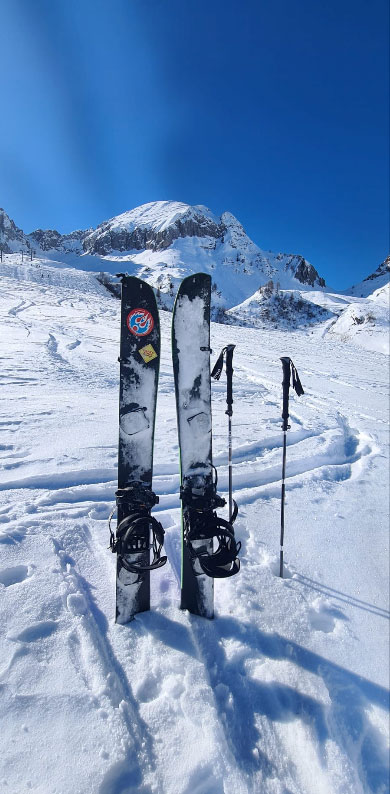
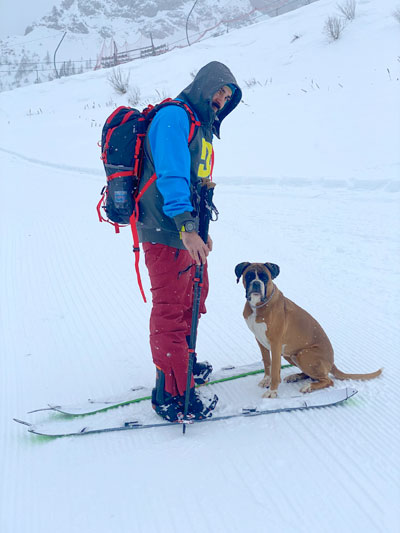
Max with his big dog Hera.
Descending with Hera side by side, me on the board and her running freeriding is one of the most fun things of the day.
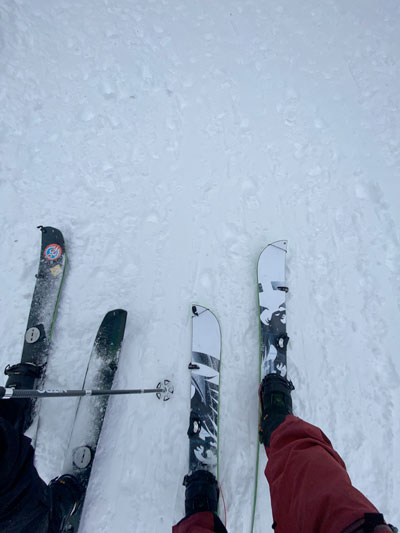
Our boards in ascent mode
On the left is my Nitro Doppleganger and on the right is Max's Neversummer Splitboard.
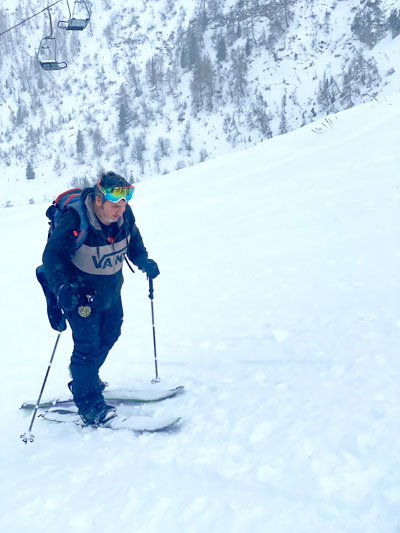
MaikP as he climbs the mountain
Here I had almost reached my terminus, from the photo you can't see much but the climb was quite steep.
